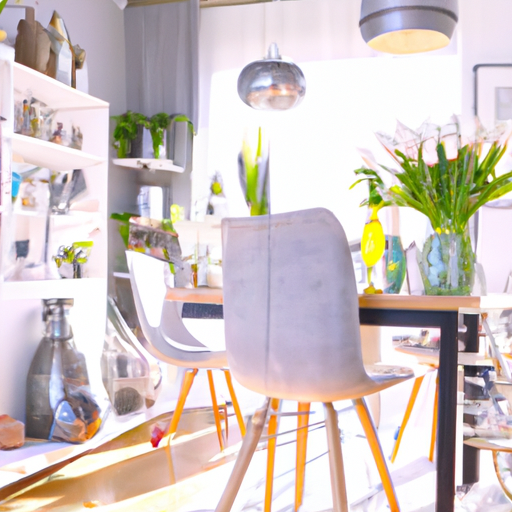Maximizing Space and Functionality for Entertaining
Creating a home that is perfect for hosting guests requires careful planning and design considerations. The key to achieving this is to maximize space and functionality for entertaining. This article will discuss various design aspects that can help you create a welcoming and comfortable environment for your guests, ensuring that your home is the ideal setting for social gatherings and memorable occasions.
One of the most important aspects of designing a home for entertaining is to create an open and spacious layout. This can be achieved by incorporating open floor plans, which allow for easy movement and interaction between different areas of the house. Open floor plans not only create a sense of spaciousness, but they also facilitate better communication and socializing among guests. To further enhance the flow of your home, consider installing wide doorways and hallways, as well as minimizing the number of walls and partitions.
Another crucial design consideration is the functionality of your living spaces. This involves creating areas that are versatile and can easily accommodate different types of gatherings. For instance, a large dining table can serve as a focal point for formal dinner parties, while a cozy seating area with comfortable sofas and chairs can be perfect for more casual get-togethers. Additionally, incorporating multipurpose furniture, such as extendable tables and modular seating, can help you adapt your space to suit various occasions and guest numbers.
The kitchen is often considered the heart of the home, and this is especially true when it comes to entertaining. A well-designed kitchen can make hosting guests a breeze, as it allows you to prepare and serve food efficiently. To achieve this, consider incorporating a large island or peninsula with ample seating, which can serve as a gathering spot for guests while you cook. Additionally, ensure that your kitchen is equipped with modern appliances and ample storage space to make food preparation and cleanup as seamless as possible.
Lighting plays a significant role in setting the mood and ambiance for any gathering. To create a warm and inviting atmosphere, consider incorporating a mix of ambient, task, and accent lighting throughout your home. Ambient lighting, such as chandeliers and recessed lights, provides general illumination, while task lighting, such as under-cabinet lights and floor lamps, helps with specific activities like cooking and reading. Accent lighting, such as wall sconces and pendant lights, adds visual interest and highlights architectural features. Dimmer switches are also a great addition, as they allow you to easily adjust the lighting levels to suit the occasion.
Outdoor spaces should not be overlooked when designing a home for entertaining. A well-designed outdoor area can serve as an extension of your indoor living space, providing additional room for guests to mingle and relax. Consider incorporating features such as a patio or deck, comfortable seating, and an outdoor kitchen or barbecue area to create an inviting outdoor entertainment space.
Finally, don’t forget the importance of personal touches and decorations in creating a welcoming environment for your guests. Displaying artwork, family photos, and other personal items can help make your home feel more inviting and lived-in. Additionally, incorporating elements such as soft furnishings, rugs, and plants can add warmth and texture to your space, making it more comfortable for guests.
In conclusion, designing a home that is perfect for hosting guests involves maximizing space and functionality for entertaining. By incorporating open floor plans, versatile living spaces, a well-equipped kitchen, appropriate lighting, and inviting outdoor areas, you can create a welcoming and comfortable environment that is ideal for social gatherings and memorable occasions. With careful planning and attention to detail, your home can become the perfect setting for hosting friends and family.
Choosing the Right Furniture and Decor for a Welcoming Atmosphere

Creating a home that is perfect for hosting guests requires careful consideration of various design elements, including the right furniture and decor to create a welcoming atmosphere. This article will discuss some essential design considerations to help you create a space that is both functional and inviting for your guests.
One of the most important aspects of designing a home for hosting guests is selecting the right furniture. The furniture you choose should not only be comfortable and stylish but also versatile and adaptable to accommodate different types of gatherings. For instance, a large sectional sofa can be an excellent choice for a living room, as it provides ample seating for guests and can be easily rearranged to suit different occasions. Similarly, a large dining table with extendable leaves can be a practical choice for a dining room, as it allows you to accommodate varying numbers of guests with ease.
In addition to selecting the right furniture, it is essential to consider the layout of your home when designing a space for hosting guests. A well-thought-out floor plan can help create a natural flow between different areas of your home, making it easy for guests to move around and mingle. For example, an open-concept living and dining area can be an excellent choice for hosting, as it allows guests to easily transition between spaces without feeling cramped or confined. Additionally, consider creating designated areas for different activities, such as a conversation area with comfortable seating and a separate space for games or entertainment.
Another crucial aspect of creating a welcoming atmosphere for guests is choosing the right decor. The decor you select should not only reflect your personal style but also create a warm and inviting environment for your guests. One way to achieve this is by incorporating a cohesive color scheme throughout your home. Choose a palette of complementary colors that can be used in different rooms to create a sense of continuity and harmony. Additionally, consider incorporating a mix of textures and patterns to add visual interest and depth to your space.
Lighting is another essential element in creating a welcoming atmosphere for guests. A well-lit space can instantly make your home feel more inviting and comfortable. Consider incorporating a mix of ambient, task, and accent lighting to create a warm and inviting environment. For example, use floor lamps and table lamps to provide soft, ambient lighting in your living room, while pendant lights or chandeliers can add a touch of elegance to your dining area. Additionally, consider using dimmer switches to allow you to easily adjust the lighting levels to suit different occasions and moods.
Finally, don’t forget the importance of personal touches when designing a home for hosting guests. Adding personal touches, such as family photos, artwork, and decorative accessories, can help make your space feel more welcoming and inviting. Consider displaying a collection of your favorite books or incorporating unique pieces of art that reflect your personality and interests. Additionally, adding fresh flowers or plants can instantly brighten up your space and create a welcoming atmosphere for guests.
In conclusion, creating a home that is perfect for hosting guests requires careful consideration of various design elements, including the right furniture, layout, decor, lighting, and personal touches. By taking the time to thoughtfully plan and design your space, you can create a welcoming and inviting environment that both you and your guests will enjoy.
Integrating Smart Home Technology for a Seamless Guest Experience
In today’s fast-paced world, technology has become an integral part of our daily lives. From smartphones to smart homes, we are constantly surrounded by gadgets and devices that make our lives easier and more convenient. One area where technology has made a significant impact is in the realm of home design, particularly when it comes to creating spaces that are perfect for hosting guests. By integrating smart home technology into your home, you can create a seamless guest experience that will leave your friends and family impressed and eager to return.
One of the first aspects to consider when designing a home that is perfect for hosting guests is the overall layout and flow of the space. Open-concept floor plans are ideal for entertaining, as they allow for easy movement between different areas of the home and encourage social interaction. By incorporating smart home technology into this design, you can further enhance the guest experience by allowing for seamless control of lighting, temperature, and even music throughout the space.
For example, smart lighting systems can be programmed to create different moods and atmospheres depending on the occasion. Soft, warm lighting can be used for intimate dinner parties, while brighter, more energetic lighting can be employed for lively gatherings. Additionally, smart thermostats can be set to automatically adjust the temperature based on the number of guests in the home, ensuring that everyone remains comfortable throughout the event.
Another important aspect of creating a home that is perfect for hosting guests is ensuring that there is ample seating and gathering spaces. This can be achieved through the use of modular furniture, which can be easily rearranged to accommodate different group sizes and activities. Smart home technology can also play a role in this area, with devices such as smart TVs and sound systems allowing for easy streaming of movies, music, and other entertainment options.
In addition to providing entertainment, smart home technology can also help to create a more secure and welcoming environment for your guests. For instance, smart doorbells and security cameras can be used to monitor the exterior of your home, allowing you to greet your guests as soon as they arrive and ensure their safety throughout their stay. Furthermore, smart locks can be programmed to provide temporary access codes for your guests, eliminating the need for physical keys and providing an added layer of security.
One of the most significant benefits of integrating smart home technology into your guest-hosting efforts is the ability to control and monitor various aspects of your home remotely. This means that even if you are not physically present, you can still ensure that your guests are comfortable and well taken care of. For example, you can adjust the temperature, lighting, and even start a pot of coffee from your smartphone, ensuring that your home is ready to welcome your guests as soon as they arrive.
In conclusion, creating a home that is perfect for hosting guests involves careful consideration of various design elements, including the overall layout, furniture, and lighting. By integrating smart home technology into this design, you can create a seamless guest experience that not only impresses your friends and family but also makes their stay more enjoyable and comfortable. From smart lighting systems and thermostats to security devices and entertainment options, there are numerous ways in which technology can enhance your home and make it the ideal space for hosting guests.
Q&A
Question 1: What are the key design considerations for creating a home that’s perfect for hosting guests?
Answer 1: The key design considerations for creating a guest-friendly home include having an open and spacious layout, creating comfortable and inviting seating areas, ensuring adequate lighting, incorporating versatile and functional furniture, and providing ample storage and organization options.
Question 2: How can I design a guest bedroom that is comfortable and welcoming for visitors?
Answer 2: To design a comfortable and welcoming guest bedroom, choose a high-quality mattress and bedding, provide various pillow options, use soothing and neutral colors, add soft lighting, and include thoughtful touches such as a bedside table, reading materials, and extra blankets.
Question 3: What are some ways to make my living room more inviting and conducive to entertaining guests?
Answer 3: To make your living room more inviting and conducive to entertaining guests, arrange furniture to encourage conversation, add comfortable seating options, use area rugs to define spaces, incorporate ambient and task lighting, and include decorative elements that reflect your personal style and create a warm atmosphere.
Conclusion
In conclusion, creating a home that is perfect for hosting guests involves thoughtful design considerations that prioritize comfort, functionality, and aesthetics. This includes providing ample seating and sleeping arrangements, ensuring proper lighting and temperature control, creating designated spaces for entertainment and relaxation, incorporating versatile and durable furniture, and adding personal touches that reflect the homeowner’s style and taste. By carefully planning and designing a welcoming and accommodating space, homeowners can create an inviting atmosphere that encourages social interaction and memorable experiences for their guests.


